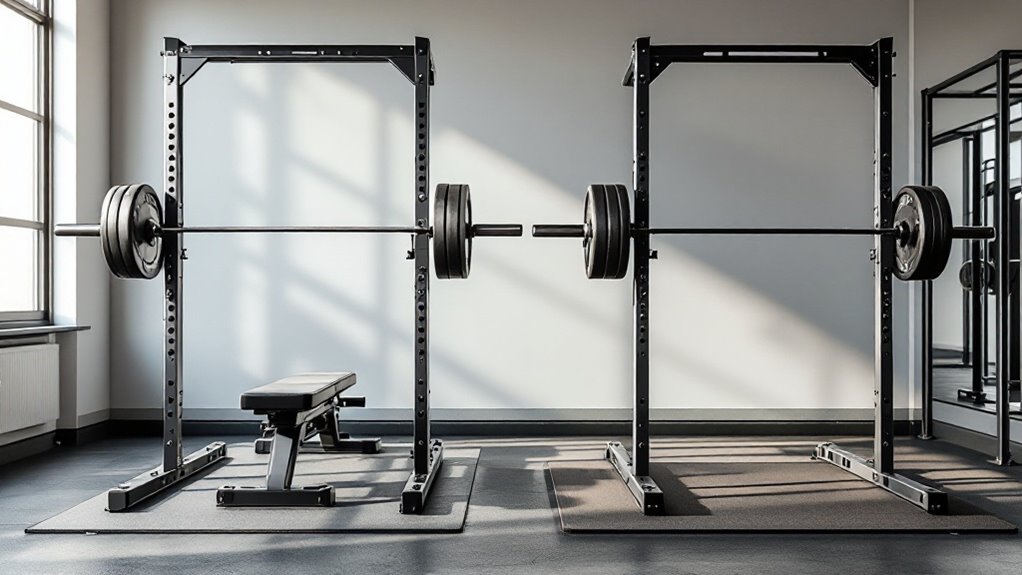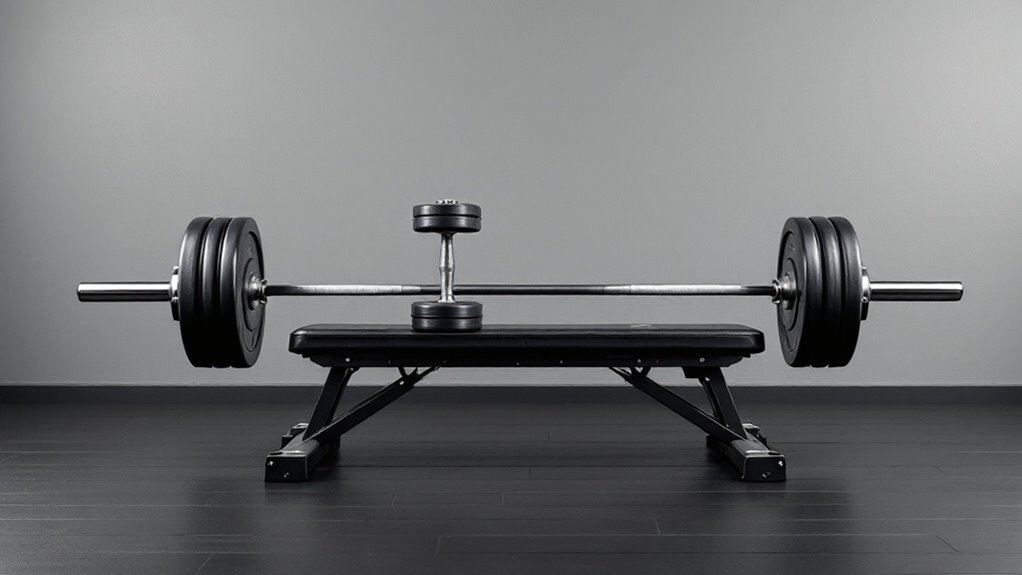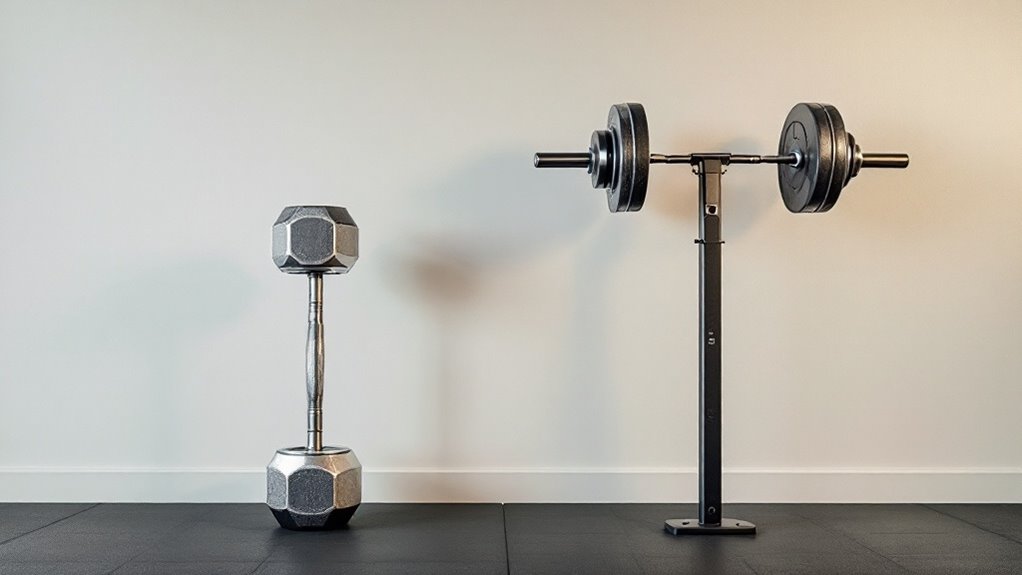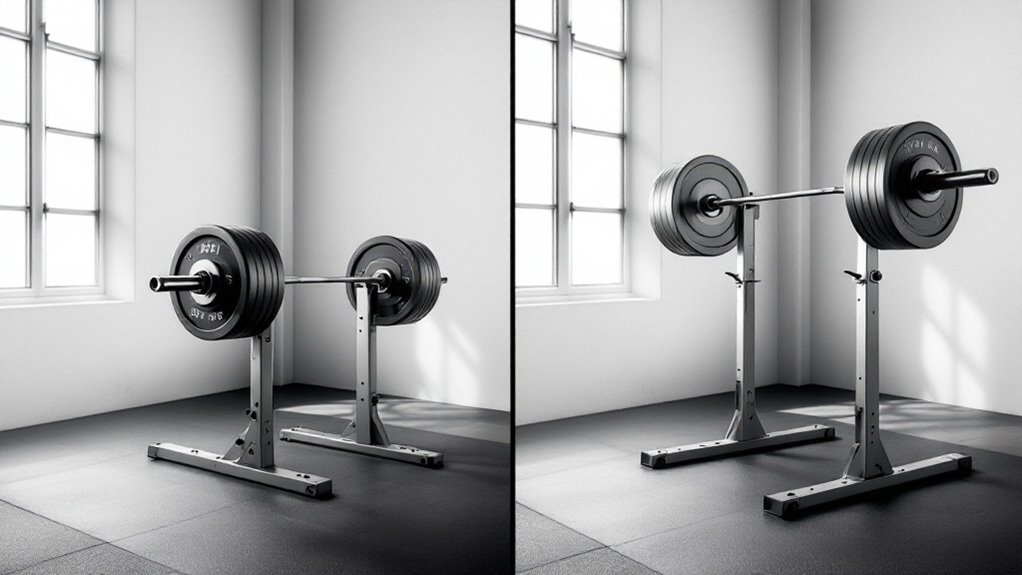Shoulder Press Vs Overhead Press

The shoulder press and overhead press target similar muscle groups but differ in execution and benefits. Shoulder press is performed seated, isolating deltoid development with lighter weights and minimal lower body involvement. Overhead press requires standing position, employing full-body stabilization for heavier loads and explosive power development. Both exercises improve shoulder strength and posture, with overhead press offering greater functional strength potential. Understanding these key distinctions helps optimize training for specific fitness goals.
Key Takeaways
- Shoulder press is performed seated to isolate shoulder muscles, while overhead press requires standing and engages more muscle groups.
- Overhead press allows for heavier weights and explosive power development, making it better suited for strength training goals.
- Both exercises target deltoids and triceps, but overhead press recruits additional stabilizing muscles throughout the body.
- Beginners should start with shoulder press to master form before progressing to the more complex overhead press.
- Overhead press involves a slight backward bar path around the face, while shoulder press follows a more vertical movement pattern.
Key Differences Between Shoulder Press and Overhead Press

While both exercises target shoulder development, the shoulder press and overhead press have distinct characteristics that set them apart in technique and muscle involvement.
The shoulder press typically utilizes a seated position, isolating the deltoids by minimizing lower body participation. Like a sniper focusing on a single target, this movement zeroes in on shoulder development.
The overhead press, performed standing, recruits additional muscle groups including the core, lower back, and legs for stabilization – think of it as deploying your entire arsenal.
The overhead press also allows for heavier weight loads and more explosive power development, making it the go-to choice for strength athletes and CrossFit warriors.
Both exercises benefit from implementing progressive overload principles to consistently build strength and muscle mass over time.
Proper Form and Technique for Each Movement

To execute these powerful shoulder movements safely and effectively, athletes must master proper form for both variations.
The shoulder press requires sitting upright on a bench with back support, gripping dumbbells at shoulder level, and pressing directly overhead while maintaining neutral wrists. Core activation is essential.
Proper form during the seated shoulder press means maintaining an upright posture, neutral wrists, and engaged core while pressing dumbbells overhead.
For the overhead press, athletes stand with feet shoulder-width apart, holding a barbell at the upper chest.
The bar path travels slightly backward around the face before reaching full extension overhead. Glutes and core must remain tight throughout the movement to protect the lower back.
Both exercises follow the principle of linear progression where beginners should gradually increase weight while maintaining perfect form.
Muscle Groups Targeted and Benefits

Both shoulder press and overhead press movements target multiple muscle groups through different involvement patterns. The shoulder press primarily involves the anterior deltoids, with secondary activation of the lateral deltoids, triceps, and upper chest. Core stabilizers also play an essential role.
The overhead press recruits a broader range of muscles, including all three deltoid heads, triceps, upper trapezius, and serratus anterior. The movement's full-body nature also demands greater core participation and upper back stability.
Benefits of both exercises include increased shoulder strength, improved posture, upgraded functional fitness, and greater overhead pressing power for athletic performance and daily activities. Like core strength training, these pressing movements can be modified for different fitness levels while maintaining proper form.
Programming and Exercise Selection Guidelines

Selecting the right pressing variation and incorporating it effectively into a training program requires careful consideration of several factors, including training experience, mobility limitations, and specific fitness goals.
For ideal results, trainers recommend following these programming guidelines:
- Begin with shoulder press variations for novice lifters to develop proper form and shoulder stability.
- Progress to overhead press movements as technique and strength improve.
- Incorporate both variations strategically based on training phase, with overhead press during strength blocks and shoulder press during hypertrophy cycles.
Volume and frequency should be adjusted according to recovery capacity and overall program structure. Consider supplementing your pressing routine with incline dumbbell presses to target upper chest development more effectively.
Frequently Asked Questions
Can I Perform Shoulder Presses or Overhead Presses if I Have Shoulder Impingement?
Working out with shoulder impingement requires caution and medical guidance.
It's generally recommended to avoid overhead pressing movements until the condition improves, as they can worsen symptoms and delay recovery.
Alternative exercises like lateral raises, front raises, and modified pressing movements at lower angles may be safer options.
Consulting a physical therapist can provide specific exercises suited to individual conditions.
Which Press Variation Is Better for Building Broader, More Aesthetic Shoulders?
Like sculptors choosing their finest tools, both pressing variations can carve impressive shoulders, but the overhead press typically edges out its cousin for overall shoulder development.
With a fuller range of motion and greater deltoid activation, the overhead press demands more from the anterior, lateral, and posterior deltoid heads.
However, shoulder presses can be gentler on the joints while still building aesthetic width.
Should I Alternate Between Shoulder Press and Overhead Press Weekly?
Alternating between these pressing variations weekly can provide beneficial stimulus variety while targeting deltoid muscles from slightly different angles.
This strategy helps prevent training plateaus and reduces movement pattern fatigue.
However, consistency with one variation for 4-6 weeks before switching may produce better strength gains by allowing proper motor pattern development and progressive overload tracking.
Are Behind-The-Neck Shoulder Presses Safe to Perform Regularly?
Behind-the-neck shoulder presses carry significant risks and aren't recommended for regular training.
This movement places excessive stress on the shoulder joints and rotator cuffs while forcing an unnatural range of motion. The position compromises spinal arrangement and can lead to neck strain.
Traditional front-facing overhead presses offer similar benefits with substantially lower injury risk and better biomechanical efficiency.
What Weight Percentage Difference Should I Expect Between These Two Exercises?
Like comparing a sports car to a supercar, both movements showcase impressive strength, but with subtle performance differences.
Most lifters can typically handle 5-10% less weight with behind-the-neck presses compared to standard overhead presses.
This variance stems from biomechanical factors and reduced stability in the behind-the-neck position.
For ideal progression tracking, start with 90-95% of your overhead press weight when attempting behind-the-neck variations.
Final Thoughts
Both the shoulder press and overhead press are fundamental movements for building upper body strength and power. While they share similarities, each exercise offers unique benefits and applications in training programs. Understanding proper form, targeted muscles, and programming considerations allows lifters to strategically implement both movements. Whether pursuing strength, hypertrophy, or athletic performance, mastering these pressing variations creates a solid foundation for overhead pressing success.


